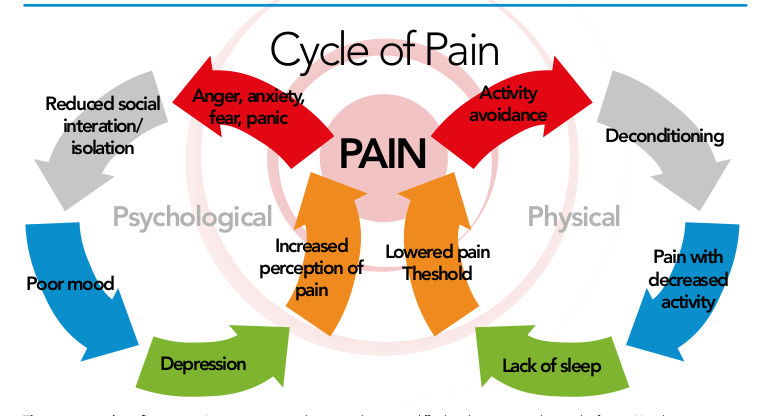La connexion corps-esprit : comment les pensées et les émotions peuvent créer une douleur chronique

Chronic pain is a complex and debilitating condition that affects millions of people around the world. While it is commonly believed that pain is purely a physical sensation, growing evidence suggests that our thoughts and emotions play a significant role in the development and persistence of chronic pain.

This article explores the fascinating connection between our minds and bodies, shedding light on how thoughts and emotions can create and perpetuate chronic pain.
The Mind-Body Connection
The mind-body connection is the intricate relationship between our mental and emotional states and our physical well-being. It is a two-way street, where not only can our physical health affect our mental and emotional states, but our thoughts and emotions can also influence our physical health. This connection is particularly evident in the context of chronic pain.
- Stress and Pain
Stress is a well-known factor in the creation of chronic pain. When we experience stress, our bodies release stress hormones such as cortisol, which can increase inflammation and muscle tension. This heightened physiological response can amplify pain perception. In other words, high levels of stress can make chronic pain feel more intense and harder to manage.Moreover, chronic stress can lead to a condition called central sensitization, where the nervous system becomes more reactive to pain signals. This can result in the brain interpreting non-painful sensations as painful, leading to a heightened sense of discomfort and even the development of new pain symptoms.
- Negative Emotions and Pain
Negative emotions, such as anxiety, depression, and anger, are closely linked to chronic pain. When we experience these emotions, our brain's pain-processing centers become more active, intensifying the perception of pain. Furthermore, negative emotions can lead to maladaptive behaviors, such as decreased physical activity and disrupted sleep patterns, which can exacerbate chronic pain conditions.
- Catastrophic Thinking
Catastrophic thinking refers to the tendency to believe the worst possible outcome is imminent. In the context of chronic pain, this type of thinking can be particularly harmful. Individuals who engage in catastrophic thinking about their pain often experience heightened pain perception and greater disability. These thoughts can create a self-fulfilling prophecy, as the anticipation of pain can make it more likely to occur.
- The Placebo and Nocebo Effect
The placebo effect is a well-documented phenomenon in medicine where individuals experience relief from their symptoms after receiving a treatment with no active ingredients. The mere belief in the effectiveness of a treatment can trigger the brain's natural pain-relief mechanisms.Conversely, the nocebo effect is the opposite – it occurs when individuals experience negative side effects or increased pain because they believe a treatment will be ineffective or cause harm. These effects demonstrate the significant role our thoughts and beliefs play in our experience of pain.

Breaking the Cycle: Psychological Strategies for Chronic Pain ManagementChronic pain is often a multi-faceted problem, and addressing its psychological components is essential for effective management.
Here, we delve further into strategies to break the cycle of pain by focusing on the mind-body connection and introduce the vital role of bodywork in chronic pain management.
- Cognitive-Behavioral Therapy (CBT):
- Identifying Negative Thought Patterns: CBT helps individuals recognize and challenge negative thought patterns associated with their pain. This might involve acknowledging and modifying irrational beliefs, such as "I will always be in pain" or "There's nothing I can do to help myself."
- Behavioral Changes: CBT also focuses on altering behaviors that contribute to pain, such as avoidance of physical activities or overuse of pain medication. Individuals learn more adaptive coping strategies, fostering a sense of control and self-efficacy.
- Mindfulness and Meditation:
- Emotional Regulation: Mindfulness practices encourage individuals to become aware of their thoughts and emotions without judgment. This emotional regulation can reduce the amplification of pain perception associated with negative emotions.
- Stress Reduction: By practicing mindfulness meditation or relaxation techniques, individuals can reduce the physiological response to stress, including muscle tension and increased inflammation. This can lead to decreased pain intensity and better pain management.
- Social Support:
- Emotional Relief: Sharing the burden of chronic pain with friends, family, or support groups can provide emotional relief. Connecting with others who understand their experiences can reduce feelings of isolation and depression, contributing to overall well-being.
- Practical Assistance: A strong support system can also offer practical assistance in daily life, making it easier to cope with the physical limitations that chronic pain can impose.
- Physical Activity:
- Endorphin Release: Regular, gentle exercise can stimulate the release of endorphins, which are the body's natural painkillers. Engaging in activities such as swimming, yoga, or walking can help reduce pain perception and improve mood.
- Improved Functionality: Over time, physical activity can increase physical functionality, reduce muscle tension, and promote better sleep. These improvements can significantly enhance an individual's overall quality of life.

The Vital Role of Bodywork in Chronic Pain Management
In addition to psychological strategies, bodywork plays a vital role in the holistic approach to managing chronic pain. Bodywork encompasses a range of therapeutic techniques aimed at addressing physical discomfort and restoring balance in the body. Here's why it's essential:
- Pain Relief through Physical Manipulation: Bodywork techniques like Shiatsu therapy, chiropractic care, and physical therapy can directly target areas of pain and tension in the body. Skilled practitioners can manipulate muscles, joints, and connective tissues to alleviate pain, increase flexibility, and improve circulation.
- Stress Reduction: Bodywork techniques often incorporate relaxation and stress-reduction components. The calming environment and hands-on approach can reduce stress and anxiety, which, as mentioned earlier, can exacerbate chronic pain.
- Improved Body Awareness: Bodywork sessions can enhance an individual's awareness of their body, helping them identify areas of tension and discomfort. This heightened awareness empowers individuals to take proactive steps in managing their pain.
- Complementary to Psychological Approaches: Bodywork can work in synergy with psychological strategies like CBT and mindfulness. By addressing both the physical and emotional aspects of pain, individuals can experience a more comprehensive and effective pain management approach.
- Long-Term Maintenance: Bodywork can be a valuable part of long-term pain management, helping individuals maintain physical well-being and prevent the recurrence of pain.
In conclusion, addressing the psychological components of chronic pain is a crucial step toward breaking the cycle of suffering.
Psychological strategies, combined with bodywork, provide a holistic approach to chronic pain management. By integrating these approaches, individuals can gain better control over their pain, improve their overall quality of life, and work towards a pain-free future.
Let me know if you have any questions?
Mihael Mamychshvili